Mathea Ford's Blog
July 11, 2025
What Produce Can You Eat and NOT Eat with Kidney Disease-Podcast

Chronic Kidney Disease (CKD) affects millions of people worldwide, and managing it requires more than just medication. One of the most powerful tools in controlling CKD is diet. Making thoughtful food choices can slow the progression of the disease and improve quality of life. In this post, we'll focus on the importance of fruits and vegetables in a kidney-friendly diet and highlight the best low-potassium, low-phosphorus, and low-sodium options.
For More Recipes and Ideas --->> Get Your Free Meals and Recipes That Are Perfect for Pre-Dialysis Diets, Pre-Dialysis with Diabetes, or Dialysis Diets.
Why Produce Matters for Kidney HealthFor individuals with CKD, not all fruits and vegetables are created equal. Some produce items can actually worsen kidney health due to their high levels of potassium, phosphorus, or sodium. These minerals are typically restricted in a renal diet because damaged kidneys struggle to filter them properly. Eating the right fruits and vegetables helps reduce the burden on your kidneys while still supplying essential nutrients.
Recommended Fruits for CKDWhen selecting fruits, it's important to focus on options that are naturally low in potassium and phosphorus. These fruits provide vitamins, fiber, and hydration without overloading your kidneys.
Here are some of the best choices:
Apples â Low in potassium and a great source of fiber.Berries â Including blueberries, strawberries, and raspberries. These are rich in antioxidants and low in potassium.These fruits are not only safe for kidney health but also help support overall wellness. Incorporating them into your daily meals or snacks can make your renal diet both enjoyable and beneficial.
Recommended Vegetables for CKDLike fruits, vegetables are vital for health, but choosing the right ones is key when managing CKD. Look for low-potassium, low-phosphorus, and low-sodium options that are still rich in nutrients.
Top kidney-friendly vegetables include:
Bell Peppers â High in vitamins A and C, and low in potassium.Cucumbers â Hydrating and very low in potassium.Cauliflower â A versatile vegetable rich in fiber, folate, and vitamin C.These vegetables can be steamed, sautéed, or eaten raw, making them easy to incorporate into a variety of meals while supporting kidney health.
How These Foods HelpLow-potassium, low-phosphorus, and low-sodium produce reduces the strain on your kidneys. By selecting these specific fruits and vegetables, you allow your kidneys to function more efficiently. At the same time, you're getting vital nutrients like fiber, vitamins, and antioxidants, all of which support overall health without increasing the workload on your kidneys.
Managing CKD through diet doesn't mean sacrificing flavor or variety. By focusing on kidney-friendly fruits and vegetables like apples, berries, bell peppers, cucumbers, and cauliflower, you can support your kidney health while enjoying delicious meals. Always consult with your healthcare provider or a renal dietitian to personalize your diet and make sure you're making the best choices for your individual needs.
Eating well with CKD is possibleâand it starts with choosing the right produce.
Be sure to subscribe to our updates and check out more CKD-safe recipes and guidance at RenalDietHQ.com.
ð§Â Want more details and tips? Listen to the full podcast episode here:
ð Learn more about: Can I Eat Quinoa on a Renal Diet? | Kidney-Friendly Food Tips-Podcast
The post What Produce Can You Eat and NOT Eat with Kidney Disease-Podcast appeared first on Renal Diet HQ.
July 4, 2025
Can I Eat Quinoa on a Renal Diet? | Kidney-Friendly Food Tips-Podcast

Quinoa is more than just a trendy superfood. Itâs a nutrient-dense seed that offers important health benefits, especially for individuals with chronic kidney disease (CKD). In this blog post, weâll explore how quinoa fits into a kidney-friendly diet, why itâs considered a complete protein, and how it can help support your overall wellness. If you're looking for a satisfying, kidney-smart food option, quinoa might be the answer.
For More Recipes and Ideas --->> Get Your Free Meals and Recipes That Are Perfect for Pre-Dialysis Diets, Pre-Dialysis with Diabetes, or Dialysis Diets.
Quinoa as a Complete ProteinQuinoa is well known for being a complete plant-based protein. This means it contains all nine essential amino acids your body needs to function properly. For people managing CKD, especially in the early stages, getting adequate, high-quality protein can be essential. Quinoa provides this without the high levels of phosphorus and saturated fats that often come with animal proteins. It supports muscle maintenance, energy production, and overall nutritional balanceâall of which are important for kidney health.
Rich in Nutrients that Support Kidney HealthIn addition to its protein content, quinoa is packed with other nutrients that make it a standout choice for people with CKD. It contains fiber, which supports digestive health and helps control blood sugar levelsâa critical factor for those with diabetes-related kidney disease. Quinoa is also a source of antioxidants, vitamins, and minerals such as magnesium and iron, which help reduce inflammation and oxidative stress, both of which can worsen kidney damage.
Including antioxidant-rich foods like quinoa in your diet may help protect remaining kidney function and support long-term health.
Provides Sustainable EnergyOne of the challenges people with CKD face is maintaining their energy throughout the day, especially when following a restrictive diet. Quinoa is a great source of complex carbohydrates, which are digested slowly and provide a steady supply of energy. This helps avoid blood sugar spikes and crashes, making it ideal for those who need lasting fuel for daily activities without overloading their kidneys.
Versatility in Meal PlanningQuinoaâs versatility makes it an easy addition to any kidney-friendly meal plan. Itâs available in various forms, such as whole grains, flakes, or flour, allowing you to enjoy it in breakfast bowls, salads, soups, or even as a base for plant-based burgers. Its mild, nutty flavor pairs well with both savory and sweet dishes, making it suitable for many dietary preferences. And since it's naturally gluten-free, it's a safe choice for those with gluten sensitivities as well.
Quinoa is a powerhouse ingredient that fits well into a kidney-conscious lifestyle. With its complete protein profile, nutrient density, and culinary flexibility, quinoa can support your health goals while keeping your meals flavorful and satisfying. Always remember to consult with your healthcare provider or a registered renal dietitian before making significant dietary changes.
Ready to try quinoa? Add it to your next meal and see how this simple seed can help support your kidney health journey.
Be sure to subscribe to our updates and check out more CKD-safe recipes and guidance at RenalDietHQ.com.
ð§ Want more details and tips? Listen to the full podcast episode here:
ð Learn more about: What BBQ Foods Are Kidney-Friendly? Letâs Break It Down!-Podcast
ð Learn more about: Which Drinks Are SAFE for a Renal Diet? The Answers Might Surprise You!-Podcast
The post Can I Eat Quinoa on a Renal Diet? | Kidney-Friendly Food Tips-Podcast appeared first on Renal Diet HQ.
June 27, 2025
Which Drinks Are SAFE for a Renal Diet? The Answers Might Surprise You!-Podcast

Living with chronic kidney disease (CKD) often means navigating a complex landscape of dietary restrictions designed to maintain kidney function and overall health. While food limitations are widely recognized, selecting the right beverages can be just as challenging. It's essential to find drinks that not only taste good but also adhere to a strict renal diet.
For More Recipes and Ideas --->> Get Your Free Meals and Recipes That Are Perfect for Pre-Dialysis Diets, Pre-Dialysis with Diabetes, or Dialysis Diets.
For individuals with CKD, staying properly hydrated is vital. However, certain common beverages, such as sugary sodas, high-caffeine energy drinks, or even some fruit juices rich in potassium, can negatively impact kidney health. This makes it crucial to explore alternative, kidney-friendly drink options that are both flavorful and supportive of your health.
The Crucial Role of Hydration for Kidney HealthProper hydration plays a fundamental role in overall health, especially for those managing kidney disease. Fluids are essential for helping your kidneys flush out waste products and toxins from the body, which is particularly important when kidney function is compromised. Beyond waste elimination, adequate fluid intake also aids in maintaining normal blood pressure, reducing swelling caused by fluid retention, and supporting healthy digestion and circulation.
For most individuals with CKD, consistently drinking fluids, often around eight glasses a day, helps ensure the body remains properly hydrated, nourishing cells and keeping your system functioning optimally. However, it's vital to always follow your doctor's specific recommendations if they advise a different fluid intake.
Ignoring proper hydration can lead to negative effects such as fatigue, dizziness, and poor cognitive function. Staying well-hydrated is key to maintaining energy levels and even reducing the risk of infection. For those on a renal diet, selecting the
right types of fluids is just as important as the amount consumed. Prioritizing beverages that offer both hydration and nutritional benefits is key to supporting kidney health without putting additional strain on your body.
Meet the Expert: Your Guide to a Healthier Renal DietHello! I'm Mathea Ford, a Registered Dietitian Nutritionist specializing in chronic kidney disease and the proud owner of RenalDietHQ.com. My passion lies in helping individuals just like you improve their health through simple yet delicious changes to their meals. Together, we can transform your eating habits, boost your overall well-being, and ensure you truly enjoy every bite along your health journey. Say goodbye to bland, boring meals and say hello to a healthier, more vibrant life! Visit RenalDietHQ.com today to take the first step towards better kidney health.
Kidney-Friendly Non-Alcoholic Beverage OptionsWhen managing a renal diet, choosing non-alcoholic beverages wisely is paramount. Fortunately, there's a wide variety of delicious and kidney-safe options available to keep you refreshed and hydrated.
Herbal Teas: A Flavorful and Beneficial ChoiceHerbal teas are a fantastic non-alcoholic beverage option for anyone following a renal diet. With their diverse range of flavors and potential health benefits, they offer a delightful way to stay hydrated while actively supporting kidney health.
Chamomile Tea: Known for its calming effects, chamomile tea can help reduce stress and anxiety. It also offers mild anti-inflammatory properties that may benefit conditions like arthritis and is an excellent choice for improving sleep quality, especially before bedtime.Peppermint Tea: This popular variety is recognized for supporting digestion, boosting immunity, and alleviating sore throats and congestion. The antioxidants in peppermint tea may also contribute to lower cholesterol levels, making it a valuable addition to a renal diet.Hibiscus Tea: Particularly noted for its ability to lower blood pressure, hibiscus tea can also relieve bloating and cramping, and reduce fatigue often associated with PMS. Its diuretic effects may further support kidney function by promoting the elimination of waste products.Ginger Tea: A great option for reducing inflammation and alleviating nausea, ginger tea can also help with cold symptoms like coughing or sneezing.With such a rich variety of herbal teas available, each offering unique therapeutic benefits, these beverages can be a refreshing and health-promoting addition to any renal diet.
Refreshing Juice AlternativesWhile water is always the top choice for staying hydrated, there are several tasty juice alternatives that can provide flavor without compromising kidney health.
Cranberry Juice: An excellent option that is low in sodium and high in antioxidants. Cranberry juice offers anti-inflammatory properties that can help reduce inflammation linked to kidney disease. It's also rich in vitamins A and C, as well as beneficial amounts of potassium and magnesium, all of which support kidney health.Apple and Orange Juices: These are also good choices, providing similar benefits with a naturally sweeter flavor profile.Enhancement Tip: Adding a splash of lemon or lime juice can further enhance the refreshing taste without the need for extra added sugar.Nutrient-Rich Smoothies and ShakesSmoothies and shakes offer an excellent way for individuals on a renal diet to enjoy a tasty, nutrient-rich treat while adhering to dietary restrictions.
Fruit Choices: When crafting smoothies for kidney disease, it's important to focus on low-potassium fruits such as apples, oranges, strawberries, blueberries, and grapes. These fruits deliver essential vitamins and minerals without overwhelming the kidneys.Vegetable Boost: Incorporating small amounts of vegetables like kale or spinach can further boost the nutritional content while maintaining kidney health.Dairy-Free Options: Plant-based milks, such as almond or coconut milk, can effectively replace traditional dairy, which might contain too much phosphorus for a renal diet.Protein Power: To increase protein content without adding excess sodium, low-sodium protein powders are an excellent addition.Shake Bases: Shakes are also a great option, particularly when using non-fat Greek yogurt as a base. This provides a good source of calcium and protein while keeping fat content low.Natural Sweetness & Fiber: Frozen fruits can add natural sweetness, reducing the need for sugary syrups or additives. Whole grain oats are another valuable ingredient, providing beneficial fiber and additional nutrients.Key Consideration: Always measure portions carefully to avoid exceeding limits set by your physician or dietitian. Remember to read food labels to ensure all ingredients fit within your renal diet. With a bit of creativity and careful planning, you can enjoy these delicious beverages without compromising your kidney health.Plant-Based Milks: Dairy AlternativesThe global plant-based milk market has seen rapid growth, reflecting a widespread desire for non-dairy alternatives to traditional cow's milk. Among the most popular options are soy milk, almond milk, coconut milk, and oat milk, each offering distinct benefits for those on a renal diet.
Soy Milk: Made from soybeans, soy milk is rich in protein, calcium, and magnesium, and is often fortified with vitamins like A, D, and B12. Its neutral flavor and creamy texture make it a versatile ingredient in many recipes.Almond Milk: Known for its natural sweetness and low-calorie content, almond milk is a great choice for individuals monitoring their weight or sugar intake. However, it's important to note that almond milk is typically low in protein unless specifically fortified with additional nutrients like pea protein powder.Low-Potassium Sodas and Soft DrinksFor individuals looking to maintain kidney health, low-potassium sodas and soft drinks can be a great option to help quench thirst without worrying about high potassium levels. Many people are unaware that even seemingly harmless carbonated beverages like sodas can contain significant amounts of potassium or phosphorus, which may pose a risk for those with impaired renal function. Fortunately, alternatives are available that provide hydration without the concern of excessive potassium intake. Sparkling waters and flavored seltzers, for example, offer refreshing options without adding unnecessary potassium, making them a safe choice for kidney-friendly hydration.
Coffee AlternativesIf you're on a renal diet and seeking coffee alternatives, there are plenty of options to satisfy your cravings without the high caffeine and acidity.
Herbal Coffees: These have become increasingly popular, offering the rich flavor of coffee without the potential harmful effects associated with regular coffee. They are a great way to enjoy a warm, comforting drink without compromising your kidney health.Iced Options: For those who prefer something cold, many brands offer herbal iced tea mixes that provide a satisfying taste without the caffeine.Other Substitutes: Smoothies made with almond milk, various fruit juice combinations, and even hot cocoa can serve as enjoyable substitutes for traditional coffee.Mocktails & Alcohol-Free CocktailsMocktails and alcohol-free cocktails are excellent alternatives for individuals on renal diets who still want to enjoy a fun, flavorful beverage. These drinks are typically low in calories and sugar, making them perfect for those who need to avoid excessive sugar or alcohol.
With the rising popularity of mocktails, many restaurants and bars now offer creative recipes that incorporate fresh fruits, juices, syrups, herbs, spices, and even vegetables. This allows for a wide variety of drink combinations that can cater to any taste, from sweet to savory, and can be enjoyed without the health risks associated with alcohol.
Cucumber Basil Lemonade: An example is a refreshing mocktail made with freshly pressed cucumber juice, lemon slices, simple syrup, and basil, providing a light, alcohol-free drink.Strawberry Mint Mojito: Another popular option involves muddling fresh strawberries with lime juice, adding sparkling soda water, and garnishing with mint leaves.These drinks not only look appealing but also serve as a fun and healthy alternative to traditional sugary beverages. With so many flavors and combinations to experiment with, mocktails are a great way to stay hydrated and enjoy exciting new beverages while following a renal diet.
Hot Chocolate (in moderation)Hot chocolate, in moderation, can be enjoyed by individuals on a renal diet, but it's important to be mindful of its components and their potential impact on kidney health.
Concerns: One primary concern is caffeine, which can increase blood pressure and contribute to dehydration, both potentially harmful to kidney function. Additionally, the sugar and carbohydrate content in many hot chocolate mixes can lead to weight gain, increasing the risk of high blood pressure and diabetes â conditions closely linked with kidney failure. Therefore, considering low-carb or sugar-free options is wise if these risks are a concern.Potential Benefits: On the other hand, the chocolate solids in hot chocolate, particularly unsweetened varieties, contain antioxidants known as polyphenols. These antioxidants may offer benefits by helping to reduce inflammation, potentially slowing the progression of kidney disease, especially in conditions like glomerulonephritis.Key to Enjoyment: The key to enjoying hot chocolate safely is moderation and paying close attention to ingredients like sugar and caffeine. By consulting with your dietitian and being mindful of your portions, you can enjoy a comforting cup of hot chocolate while still maintaining kidney health.Empowering Your Renal DietWhen selecting non-alcoholic beverages for a renal diet, the focus should always be on options that support hydration and overall kidney health. Drinks like flavored water, carefully chosen low-potassium fruit juices, or homemade infusions with herbs and fruits are excellent choices.
By being mindful of what you drink, you can significantly reduce the risk of complications associated with kidney disease and improve your long-term health outcomes. Ultimately, careful planning and choosing beverages that align with your nutritional needs can play a crucial role in maintaining kidney function and enhancing your overall well-being.
Be sure to subscribe to our updates and check out more CKD-safe recipes and guidance at RenalDietHQ.com.
ð§ Want more details and tips? Listen to the full podcast episode here:
ð Learn more about: Can I Eat Quinoa on a Renal Diet? | Kidney-Friendly Food Tips-Podcast
The post Which Drinks Are SAFE for a Renal Diet? The Answers Might Surprise You!-Podcast appeared first on Renal Diet HQ.
June 20, 2025
What BBQ Foods Are Kidney-Friendly? Letâs Break It Down!-Podcast

Barbecue has been an American classic since the 1800s. Whether it's ribs, grilled chicken, or smoky veggies, there's something about BBQ that brings people togetherâespecially in the summertime. But if youâre managing Chronic Kidney Disease (CKD), traditional barbecue may seem off-limits due to its high salt and additive content.
For More Recipes and Ideas --->> Get Your Free Meals and Recipes That Are Perfect for Pre-Dialysis Diets, Pre-Dialysis with Diabetes, or Dialysis Diets.
The good news? You can still enjoy this summertime favorite without compromising your health. By making smart ingredient swaps and using kidney-friendly marinades and seasonings, you can create flavorful dishes that are easier on your kidneys.
For More Recipes and Ideas --->> Get Your Free Meals and Recipes That Are Perfect for Pre-Dialysis Diets, Pre-Dialysis with Diabetes, or Dialysis Diets.
Why Traditional BBQ Can Be a Problem for CKDMany traditional BBQ dishes rely on tangy sauces and salty rubs, both of which can pose challenges for kidney health. These often contain high levels of sodium, phosphorus, and potassiumâminerals that people with CKD need to limit.
Overconsumption of these ingredients can strain the kidneys and contribute to fluid retention, high blood pressure, and other complications. Thatâs why itâs important to rethink how you flavor your food.
Smart Ingredient Swaps for Kidney HealthEnjoying BBQ with CKD starts with simple swaps:Use low-sodium BBQ sauces or make your own at home using tomato paste, vinegar, honey, and spices.Skip commercial spice rubs, which often include hidden salts and preservatives. Create your own with garlic powder, onion powder, paprika, and black pepper.Choose lean proteins like skinless chicken breast or fish instead of processed meats.Swap high-potassium sides like baked beans for grilled low-potassium vegetables such as bell peppers, zucchini, and onions.Marinades & Seasonings That WorkKidney-friendly meals donât have to be bland. You can add bold flavor with fresh ingredients:Vinegar or lemon juice adds acidity and brightness.Olive oil enhances moisture and taste.Use herbs like rosemary, thyme, and oregano to bring out the natural flavors of the food.A little garlic or ginger can go a long way in creating depth of flavor.Great CKD-Friendly Barbecue OptionsYou donât have to give up grillingâjust be mindful of the ingredients. Here are some ideas:Grilled chicken breast marinated in olive oil, lemon juice, and herbs.Foil packet meals with lean meat, low-potassium veggies, and a splash of low-sodium broth or seasoning.Veggie kabobs using mushrooms, cherry tomatoes, bell peppers, and red onions.Homemade burgers using ground turkey or beef, seasoned with salt-free spices and served on whole-grain buns.Tips for a Successful Kidney-Friendly CookoutWatch portion sizes, especially with protein.Stay hydrated, but be aware of fluid limits if youâre on dialysis.Skip processed meats like hot dogs, bacon, or sausages that are high in sodium and phosphorus.Serve with fresh fruit like berries or watermelon for a refreshing and kidney-friendly dessert.Barbecue doesnât have to be off-limits just because you have CKD. By being thoughtful about what goes on the grill and how you season your food, you can still enjoy the smoky, savory flavors of summer. With a few ingredient swaps and some creativity, you can maintain your kidney health and still participate in the traditions you love.
So fire up the grill and enjoy barbecue the kidney-friendly way!
Be sure to subscribe to our updates and check out more CKD-safe recipes and guidance at RenalDietHQ.com.
ð§Â Want more details and tips? Listen to the full podcast episode here:
ð Learn more about: What do I need to know about Adjusting my Medications as Kidney Function Changes-Podcast
The post What BBQ Foods Are Kidney-Friendly? Letâs Break It Down!-Podcast appeared first on Renal Diet HQ.
June 18, 2025
What do I need to know about Adjusting my Medications as Kidney Function Changes-Podcast

If you have chronic kidney disease (CKD), itâs important to understand how changes in kidney function can affect your medications. As your kidneys play a major role in filtering and processing drugs in your body, declining function can lead to complications if your medications arenât properly adjusted.
In this post, weâll cover why medication changes are often needed for people with CKD, what types of drugs require caution, and how to work with your healthcare provider to stay safe and effective in your treatment plan.
For More Recipes and Ideas --->> Get Your Free Meals and Recipes That Are Perfect for Pre-Dialysis Diets, Pre-Dialysis with Diabetes, or Dialysis Diets.
Why Medication Adjustment Matters in Chronic Kidney DiseaseYour kidneys are responsible for filtering waste and extra fluids, including byproducts from medications. When kidney function declines, your body may struggle to process certain drugs effectively.
This can result in:
Medication buildup, increasing the risk of harmful side effects.Reduced drug effectiveness if your kidneys canât filter or activate the medication properly.Whether youâre managing blood pressure, diabetes, infections, or other conditions, itâs essential to consider your kidney health in every medication decision.
Key Considerations for Medications and CKDDosage Adjustments May Be NecessaryMany common medicationsâincluding antibiotics, blood pressure medications, and diabetes drugsâare cleared from the body through the kidneys.
As kidney function decreases, your doctor may need to:
Reduce the dosage of these medications.Adjust the timing or frequency of doses.Monitor drug levels more closely to avoid toxicity.Without proper adjustments, medications can build up in the bloodstream, increasing the risk of side effects or complications.
Some Medications Should Be Avoided or Used with CautionCertain drugs are known to put extra stress on the kidneys or even worsen kidney function. If you have CKD, your healthcare team may recommend avoiding or limiting the following:
NSAIDs (Non-Steroidal Anti-Inflammatory Drugs):Examples: Naproxen, ibuprofen, and aspirinRisk: These medications can reduce blood flow to the kidneys and worsen kidney function, especially in high doses.Antacids and laxatives containing magnesium:Risk: Magnesium can accumulate in the body when kidney function is impaired, leading to further complications.By identifying potentially harmful medications, your care team can help you manage your condition more safely.
Chronic kidney disease requires thoughtful, ongoing medication management. Because your kidneys affect how drugs are processed, even small changes in function can mean big changes in how your body reacts to medication.
To stay safe:
Always talk to your doctor or pharmacist before starting, stopping, or changing any medications.Regularly monitor your kidney function with blood tests.Keep a current list of all your medications and supplements.Taking these steps can help you avoid complications and ensure your treatment is both safe and effective as your kidney health changes.
Need more support managing medications with CKD?
Talk with your healthcare provider about personalized medication adjustments and explore additional resources on kidney health and drug safety.
Be sure to subscribe to our updates and check out more CKD-safe recipes and guidance at RenalDietHQ.com.
ð§Â Want more details and tips? Listen to the full podcast episode here:
ð Learn more about: Can I Have Coffee on a Renal Diet? Hereâs What You Need to Know!-Podcast
The post What do I need to know about Adjusting my Medications as Kidney Function Changes-Podcast appeared first on Renal Diet HQ.
June 13, 2025
Alcohol and Kidney Disease: What No One Tells You!-Podcast

Managing chronic kidney disease (CKD) isnât just about lab results and medicationsâitâs also about lifestyle. Among the many choices that affect your health, alcohol consumption is one of the most important. In this post, weâll break down exactly how drinking impacts your kidneys, your medications, and your overall wellnessâespecially if youâre living with CKD.
For More Recipes and Ideas --->> Get Your Free Meals and Recipes That Are Perfect for Pre-Dialysis Diets, Pre-Dialysis with Diabetes, or Dialysis Diets.
Alcoholâs Strain on the KidneysIf you have CKD, your kidneys are already working harder than they should. Adding alcohol to the mix puts extra strain on these already compromised organs.
Alcohol can reduce kidney function by interfering with their ability to filter waste and regulate fluid levels. Over time, this can accelerate kidney damage. Even moderate alcohol consumption may lead to greater stress on the kidneys, especially for those in the later stages of CKD.
Interference with MedicationsOne of the lesser-known but serious risks of alcohol use is how it interacts with medications. Many people with CKD take medications to control blood pressure, blood sugar, or other related conditions.
Alcohol can either intensify or block the effects of these medications. For example:
It may raise your blood pressure unexpectedly.It could increase the side effects of pain medications or sedatives.It may reduce the effectiveness of drugs meant to protect kidney function.Thatâs why itâs vital to speak with your doctor before drinkingâeven occasionally.
Long-Term Health RisksDrinking alcohol while managing CKD increases your risk for several long-term health problems, including:
Hypertension (high blood pressure): A major contributor to kidney decline.Liver damage: The liver and kidneys work together, and damaging one puts extra pressure on the other.Heart disease and other complications: These can arise from inflammation, poor circulation, and high toxin buildup caused by alcohol.When you combine these risks with existing kidney issues, the long-term impact can be severe.
Nutritional Impact of AlcoholAlcohol isnât just hard on your kidneysâitâs also full of empty calories and sugar. These can:
Contribute to unwanted weight gain.Make blood sugar harder to control.Disrupt a renal-friendly diet that requires precision with sodium, potassium, and phosphorus levels.For CKD patients, even one or two drinks can disrupt the delicate balance needed to manage your condition effectively.
Practical Guidance for CKD PatientsIf youâre wondering whether itâs okay to enjoy the occasional drink, youâre not alone. Here are some tips to help you make safer choices:
Always consult your healthcare provider before drinking.Understand how alcohol interacts with your current medications.Consider alcohol-free alternatives if youâre socializing or celebrating.If you choose to drink, do so in strict moderation and monitor your bodyâs response carefully.Being cautious today can help protect your kidney function long term.
Alcohol might seem harmless in moderation, but for individuals with chronic kidney disease, it carries real and lasting risks. From kidney strain and medication interference to poor nutrition and long-term health complications, the effects add up.
By staying informed and working closely with your healthcare team, you can make the right choices for your health. Your kidneys will thank you for it.
Be sure to subscribe to our updates and check out more CKD-safe recipes and guidance at RenalDietHQ.com.
ð§ Want more details and tips? Listen to the full podcast episode here:
ðlearn more about: Can I Have Coffee on a Renal Diet? Hereâs What You Need to Know!-Podcast
The post Alcohol and Kidney Disease: What No One Tells You!-Podcast appeared first on Renal Diet HQ.
June 12, 2025
Apple Walnut Coleslaw
Delight in a simple, healthy coleslaw recipe that's tailored for those with chronic kidney diseaseâoffering fresh flavors and a guilt-free way to support your dietary needs.
Navigating dietary restrictions can be difficult for individuals with chronic kidney disease (CKD), but our kidney-friendly Apple and Walnut Coleslaw offers a delicious solution. Combining crisp cabbage, sweet apples, and crunchy walnuts, this low sodium coleslaw is complemented by a tangy dressing made from reduced-fat mayonnaise with olive oil, apple cider vinegar, and a hint of sugar. This recipe is both enjoyable and supportive of the nutritional needs of those managing CKD.
With over 25 years of experience as a Registered Dietitian, I focus on creating kidney-friendly recipes inspired by my parents' journey with Chronic Kidney Disease (CKD). My expertise in crafting tailored meal plans ensures that dishes like Apple Walnut Coleslaw meet the nutritional needs of those with CKD while being enjoyable. This coleslaw is a flavorful, low-sodium option that aligns with current dietary guidelines for kidney health.

This Apple Walnut Slaw is a great fit for a Chronic Kidney Disease (CKD) diet because it focuses on fresh, whole ingredients while keeping sodium and potassium levels in check. By using reduced-fat mayonnaise with olive oil and controlling sugar content, this recipe offers a healthy, flavorful option without overburdening the kidneys. Enjoy a refreshing crunch with every bite, knowing that it aligns with dietary guidelines crucial for kidney health.
This is a great dish for a picnic meal for CKD, or as part of a light lunch or supper. Try it with our Hawaiian chicken salad sandwich, or even when camping and eating our chicken ranch foil packets.
[feast_advanced_jump_to]Ingredients in Apple Walnut ColeslawFor a healthy apple coleslaw that's both kidney-friendly and low in sodium, you'll need fresh cabbage and apples, grated carrots, and crunchy walnuts.
 Cabbage: Fresh cabbage provides a crunchy base for the salad, adding texture and a mild, slightly peppery flavor.Carrots: Grated carrots introduce a touch of natural sweetness and vibrant color to the dish.Walnuts: Chopped walnuts contribute a satisfying crunch and a rich, nutty flavor, enhancing the salad's depth.Apples: Fresh apples add a juicy sweetness and a crisp bite, balancing the flavors with a hint of tartness.Mayonnaise: Reduced fat mayonnaise with olive oil offers creaminess and binds the ingredients together while keeping it lighter.Sugar: A bit of sugar enhances the overall sweetness, complementing the natural flavors of the ingredients.Apple Cider Vinegar: This vinegar provides a tangy kick that brightens the salad and balances the sweetness.Black Pepper: A dash of black pepper adds a subtle warmth and enhances the flavor dynamics of the salad.
Cabbage: Fresh cabbage provides a crunchy base for the salad, adding texture and a mild, slightly peppery flavor.Carrots: Grated carrots introduce a touch of natural sweetness and vibrant color to the dish.Walnuts: Chopped walnuts contribute a satisfying crunch and a rich, nutty flavor, enhancing the salad's depth.Apples: Fresh apples add a juicy sweetness and a crisp bite, balancing the flavors with a hint of tartness.Mayonnaise: Reduced fat mayonnaise with olive oil offers creaminess and binds the ingredients together while keeping it lighter.Sugar: A bit of sugar enhances the overall sweetness, complementing the natural flavors of the ingredients.Apple Cider Vinegar: This vinegar provides a tangy kick that brightens the salad and balances the sweetness.Black Pepper: A dash of black pepper adds a subtle warmth and enhances the flavor dynamics of the salad.See recipe card for quantities.
How to Make Apple Walnut ColeslawGet ready to enjoy a crunchy and refreshing apple walnut coleslaw that is both kidney-friendly and low in sodium, perfect for a healthy, delicious side dish. This easy recipe brings together the crispness of cabbage and apples with a creamy dressing to create a salad that's sure to please.



Hint: ðð¥ Add a splash of lemon juice to keep the apples fresh and brightâplus, it enhances the flavor without adding sodium! Perfect for a crisp, kidney-friendly crunch in every bite.
 Variations for Coleslaw with Apples and Nuts
Variations for Coleslaw with Apples and NutsApple Walnut Coleslaw offers a refreshing twist on a classic dish, combining fresh ingredients with a tangy dressing. This version is not only crunchy and delicious but also provides a unique flavor profile that will elevate your appetizer game. Here are three CKD-friendly variations to try:
Swap the Walnuts: For those who need to manage their potassium intake, consider using pecans or sliced almonds instead of walnuts. These alternatives provide a similar crunch and slightly different flavor that still complements the apple and cabbage base.Use Greek Yogurt: Replace the reduced-fat mayonnaise with Greek yogurt to reduce fat content and add a dose of protein. This modification maintains the creamy texture while enhancing the tanginess of the dressing.Add Fresh Herbs: Stir in fresh herbs such as dill or parsley to add an extra layer of flavor without adding sodium. This simple addition can make the slaw taste fresher and more vibrant, appealing to both the eyes and the palate.These variations are designed to cater to specific dietary needs while ensuring the dish remains delicious and satisfying.
 Storage Tips for Apple Walnut Coleslaw
Storage Tips for Apple Walnut ColeslawTo store your Apple Walnut Coleslaw for future enjoyment, itâs essential to follow proper storage practices to maintain its freshness. In the refrigerator, keep the coleslaw in an airtight container to retain its crisp texture and flavors for up to 3 days. Unfortunately, this dish doesn't freeze well due to the high moisture content of the ingredients, which can result in a soggy texture once thawed. For optimal taste and crunch, consuming the salad within a few days of preparation is recommended.
Top TipCustomizable Sweetness: Adjust the sugar level to suit your taste preferences or dietary needs. You can substitute sugar with a natural alternative like honey or maple syrup for a different flavor profile.Related Appetizers for Chronic Kidney DiseaseLooking for other recipes like this? Try these:
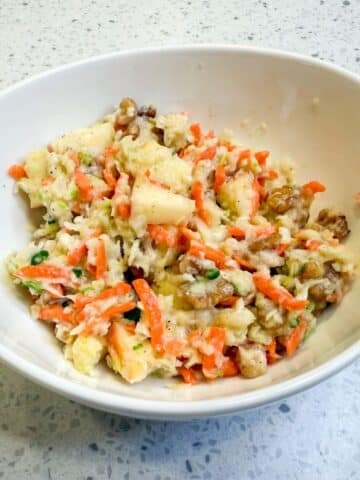 Apple Walnut Coleslaw
Apple Walnut Coleslaw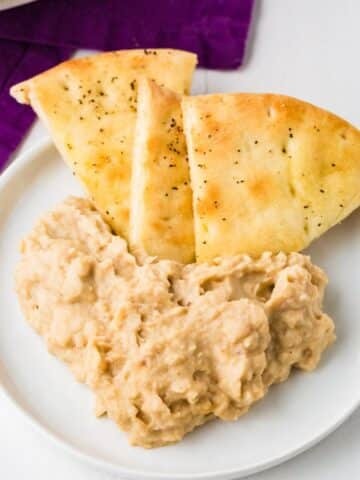 Low Sodium White Bean Dip
Low Sodium White Bean Dip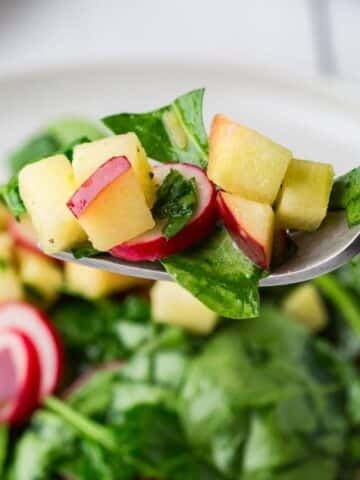 Radish Apple Salad
Radish Apple Salad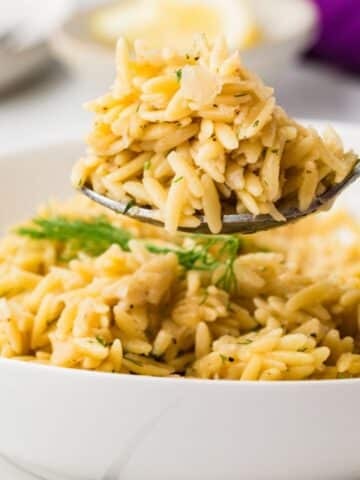 Orzo PilafPairing with Other Side Dishes
Orzo PilafPairing with Other Side DishesThese are my favorite dishes to serve with Apple Walnut Slaw:
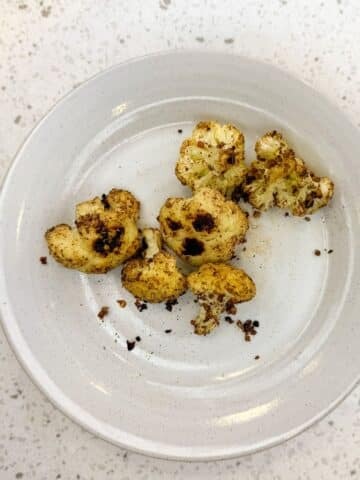 Cumin Roasted Cauliflower
Cumin Roasted Cauliflower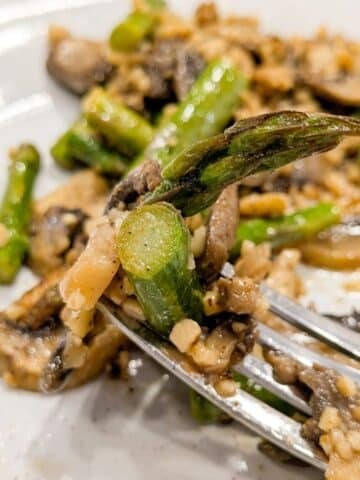 Roasted Asparagus and Mushrooms
Roasted Asparagus and Mushrooms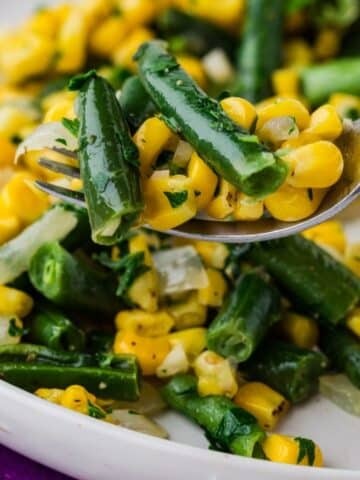 Green Beans and Corn
Green Beans and Corn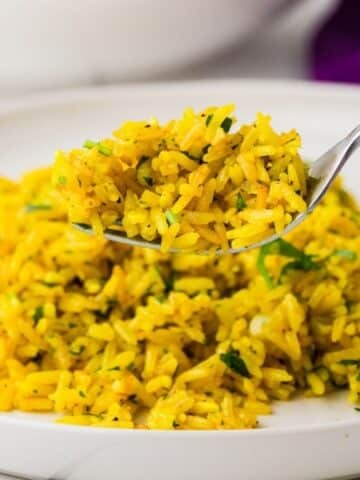 Garlic Turmeric Rice
Garlic Turmeric RiceIf you tried this Recipe or any other recipe on my website, please please leave a star rating and let me know how it goes in the comments below. I love hearing from you!
Recipe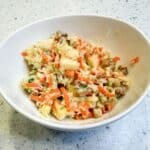 PrintApple Walnut Coleslaw#wprm-recipe-user-rating-0 .wprm-rating-star.wprm-rating-star-full svg * { fill: #343434; }#wprm-recipe-user-rating-0 .wprm-rating-star.wprm-rating-star-33 svg * { fill: url(#wprm-recipe-user-rating-0-33); }#wprm-recipe-user-rating-0 .wprm-rating-star.wprm-rating-star-50 svg * { fill: url(#wprm-recipe-user-rating-0-50); }#wprm-recipe-user-rating-0 .wprm-rating-star.wprm-rating-star-66 svg * { fill: url(#wprm-recipe-user-rating-0-66); }linearGradient#wprm-recipe-user-rating-0-33 stop { stop-color: #343434; }linearGradient#wprm-recipe-user-rating-0-50 stop { stop-color: #343434; }linearGradient#wprm-recipe-user-rating-0-66 stop { stop-color: #343434; }#wprm-recipe-user-rating-0.wprm-user-rating-allowed.wprm-user-rating-not-voted:not(.wprm-user-rating-voting) svg * { fill-opacity: 0.3; }This refreshing apple walnut coleslaw combines crunchy cabbage, grated carrots, and sweet apples with a creamy, tangy dressing, making it both kidney-friendly and low in sodium. Perfect for a healthy addition to any meal, this CKD-friendly salad is easy to prepare and can be chilled in advance.Course Appetizer, Salad, Side Dish, Side DishesCuisine AmericanDiet Diabetic, Low Fat, Low Salt, VegetarianPrep Time 1 hour hourChill Time 1 hour hourTotal Time 1 hour hourServings 4Calories 190kcalAuthor Mathea Ford, RDN, LD, MBAEquipment1 Large BowlIngredients2 cups Cabbage Fresh½ cup Carrot, Grated½ cup Walnuts, Chopped½ cup Apples Freshâ
cup Mayonnaise Reduced Fat with Olive Oil2 tablespoon Sugar3 tablespoon Apple Cider Vinegar½ teaspoon Black PepperGet ingredients with
PrintApple Walnut Coleslaw#wprm-recipe-user-rating-0 .wprm-rating-star.wprm-rating-star-full svg * { fill: #343434; }#wprm-recipe-user-rating-0 .wprm-rating-star.wprm-rating-star-33 svg * { fill: url(#wprm-recipe-user-rating-0-33); }#wprm-recipe-user-rating-0 .wprm-rating-star.wprm-rating-star-50 svg * { fill: url(#wprm-recipe-user-rating-0-50); }#wprm-recipe-user-rating-0 .wprm-rating-star.wprm-rating-star-66 svg * { fill: url(#wprm-recipe-user-rating-0-66); }linearGradient#wprm-recipe-user-rating-0-33 stop { stop-color: #343434; }linearGradient#wprm-recipe-user-rating-0-50 stop { stop-color: #343434; }linearGradient#wprm-recipe-user-rating-0-66 stop { stop-color: #343434; }#wprm-recipe-user-rating-0.wprm-user-rating-allowed.wprm-user-rating-not-voted:not(.wprm-user-rating-voting) svg * { fill-opacity: 0.3; }This refreshing apple walnut coleslaw combines crunchy cabbage, grated carrots, and sweet apples with a creamy, tangy dressing, making it both kidney-friendly and low in sodium. Perfect for a healthy addition to any meal, this CKD-friendly salad is easy to prepare and can be chilled in advance.Course Appetizer, Salad, Side Dish, Side DishesCuisine AmericanDiet Diabetic, Low Fat, Low Salt, VegetarianPrep Time 1 hour hourChill Time 1 hour hourTotal Time 1 hour hourServings 4Calories 190kcalAuthor Mathea Ford, RDN, LD, MBAEquipment1 Large BowlIngredients2 cups Cabbage Fresh½ cup Carrot, Grated½ cup Walnuts, Chopped½ cup Apples Freshâ
cup Mayonnaise Reduced Fat with Olive Oil2 tablespoon Sugar3 tablespoon Apple Cider Vinegar½ teaspoon Black PepperGet ingredients with  InstructionsShred cabbage and carrots. Chop apples into small pieces.Place the cabbage into a large salad bowl. Add the carrots and toss to combine. Place the chopped apples and walnuts in the bowl and toss again.In a separate bowl, whisk together the mayonnaise, sugar and vinegar. Add the pepper and mix together thoroughly. Pour the mixture/dressing into the cabbage mixture and mix well. Cover and refrigerate for 1 hour to chill throughout before serving. Serving size is about ¾ cup.VideoNutritionCalories: 190kcal | Carbohydrates: 16g | Protein: 3g | Fat: 14g | Saturated Fat: 2g | Polyunsaturated Fat: 9g | Monounsaturated Fat: 2g | Trans Fat: 0.01g | Cholesterol: 3mg | Sodium: 173mg | Potassium: 209mg | Fiber: 3g | Sugar: 11g | Vitamin A: 2733IU | Vitamin C: 15mg | Calcium: 38mg | Iron: 1mg | Phosphorus: 71mgCheck Out Our Meal Plans For People With Chronic Kidney Disease (CKD)
InstructionsShred cabbage and carrots. Chop apples into small pieces.Place the cabbage into a large salad bowl. Add the carrots and toss to combine. Place the chopped apples and walnuts in the bowl and toss again.In a separate bowl, whisk together the mayonnaise, sugar and vinegar. Add the pepper and mix together thoroughly. Pour the mixture/dressing into the cabbage mixture and mix well. Cover and refrigerate for 1 hour to chill throughout before serving. Serving size is about ¾ cup.VideoNutritionCalories: 190kcal | Carbohydrates: 16g | Protein: 3g | Fat: 14g | Saturated Fat: 2g | Polyunsaturated Fat: 9g | Monounsaturated Fat: 2g | Trans Fat: 0.01g | Cholesterol: 3mg | Sodium: 173mg | Potassium: 209mg | Fiber: 3g | Sugar: 11g | Vitamin A: 2733IU | Vitamin C: 15mg | Calcium: 38mg | Iron: 1mg | Phosphorus: 71mgCheck Out Our Meal Plans For People With Chronic Kidney Disease (CKD)The post Apple Walnut Coleslaw appeared first on Renal Diet HQ.
June 6, 2025
What Is a Soft Renal Diet? Easy Eating Tips for Kidney Health-Podcast

Living with Chronic Kidney Disease (CKD) often requires making important dietary changes. Among these changes, a soft CKD diet stands out as a practical and supportive option for many individuals. Itâs designed to provide kidney-friendly nutrition in a form thatâs easier to chew and digestâideal for those facing challenges with energy, dental health, or medical conditions that affect eating.
For More Recipes and Ideas --->> Get Your Free Meals and Recipes That Are Perfect for Pre-Dialysis Diets, Pre-Dialysis with Diabetes, or Dialysis Diets.
What Is a Soft CKD Diet?A soft chronic kidney disease (CKD) diet focuses on foods that are both gentle to chew and beneficial for kidney health. This approach is especially useful for people who experience difficulty chewing due to fatigue, dental problems, or other medical concerns. The soft CKD diet ensures that meals are not only easy to eat but also tailored to meet specific nutritional requirements.
Who Can Benefit from a Soft CKD Diet?This type of diet is particularly helpful for those who struggle to get enough calories or have issues with swallowing. Individuals who have low appetite, limited energy, or complications with dental health can find relief and nourishment through a soft food approach. It's especially important for people with swallowing difficulties to consult with a healthcare provider to prevent serious complications.
Why a Soft CKD Diet Is ImportantEating enough of the right nutrients is vital for managing CKD, but it can be hard when chewing or swallowing becomes difficult. A soft CKD diet helps bridge that gap by making meals more accessible without sacrificing nutritional quality. It focuses on avoiding foods that could exacerbate CKD symptoms or contribute to further decline in kidney function.
Tailoring the Diet to Individual NeedsA soft CKD diet should always be customized based on individual health status and dietary needs. Working closely with a renal dietitian or healthcare provider can ensure that the diet provides enough calories, protein, and other key nutrients. The goal is to create a sustainable, enjoyable eating plan that supports overall well-being and kidney health.
Managing CKD doesnât have to mean giving up enjoyable meals. A soft CKD diet offers a safe and effective way to continue eating well, even when chewing or swallowing becomes a challenge. By choosing the right foods and working with your healthcare team, you can maintain good nutrition and protect your kidney functionâone easy-to-chew bite at a time.
Be sure to subscribe to our updates and check out more CKD-safe recipes and guidance at RenalDietHQ.com.ð§Â Want more details and tips? Listen to the full podcast episode here:
ð Learn more about: How should I manage phosphorus intake if I love dairy products (milk, cheese, yogurt)?-Podcast
The post What Is a Soft Renal Diet? Easy Eating Tips for Kidney Health-Podcast appeared first on Renal Diet HQ.
June 4, 2025
How should I manage phosphorus intake if I love dairy products (milk, cheese, yogurt)?-Podcast

If youâve been diagnosed with Chronic Kidney Disease (CKD) and love dairy products like milk, cheese, and yogurt, you might be wondering: Do I really have to give them up? The good news isâyouâre not alone, and no, you donât necessarily have to say goodbye to your favorite foods. The key is balance and smart choices.
Phosphorus is a mineral that your kidneys normally help remove from your body. But with CKD, phosphorus can build up in your blood, causing health problems. Dairy is naturally high in phosphorus, so learning how to enjoy it in moderation is crucial.
For More Recipes and Ideas --->> Get Your Free Meals and Recipes That Are Perfect for Pre-Dialysis Diets, Pre-Dialysis with Diabetes, or Dialysis Diets.
Why Dairy Can Be a Problem for People with CKDDairy products like milk, cheese, and yogurt are rich in phosphorus. For someone with healthy kidneys, thatâs no big deal. But for people with CKD, the kidneys canât filter phosphorus efficiently. As a result, it starts to accumulate in the bloodstream.
Too much phosphorus can lead to itchy skin, weak bones, joint pain, and even damage to your heart. Thatâs why managing phosphorus intakeâespecially from dairyâis essential for kidney health.
Smart Ways to Enjoy Dairy Without Overloading on PhosphorusJust because dairy is high in phosphorus doesnât mean itâs off-limits. You can still enjoy these foods with some mindful adjustments:
Watch Your Portion SizesInstead of eating multiple servings of dairy throughout the day, try limiting yourself to just one small portion. For example:
½ cup of milk instead of a full glassOne slice of cheese instead of twoSmall changes can make a big difference in your overall phosphorus intake.
Limit How Often You Eat DairyIf you love cheese or yogurt, consider making it a once-a-day treat or even less frequently. This way, you can still enjoy your favorites without putting too much stress on your kidneys.
Choose Lower-Phosphorus Dairy OptionsSome dairy products have less phosphorus than others. Look for items that are naturally lower in phosphorus or labeled as âphosphorus-reduced.â
Look for Hidden Phosphorus AdditivesMany processed dairy products (like flavored yogurts or packaged cheeses) contain phosphorus additives, which can significantly raise your phosphorus levels. These additives are absorbed more easily than natural phosphorus in foods.
Be on the lookout for ingredients that start with:
âphos-â (like calcium phosphate or sodium phosphate)These additives are best avoided when managing CKD.
Alternatives to High-Phosphorus DairyIf dairy becomes too difficult to manage, there are great alternatives that are lower in phosphorus and often easier on the kidneys:
Unsweetened almond milkRice milkOat milkPlant-based cheese alternatives without phosphate additivesAlways check labels to ensure these options donât contain added phosphorus.
Talk to Your DietitianItâs important to work with a renal dietitian to customize your eating plan. They can help you figure out:
How much phosphorus you can safely consumeWhich dairy or dairy alternatives are best for youWhether you need phosphate binders (medication that helps block phosphorus absorption)Remember, what works for someone else might not work for youâindividual guidance is essential.
Managing phosphorus while living with CKD doesnât mean you have to cut out dairy completely. It means being aware of portion sizes, ingredient labels, and choosing lower-phosphorus alternatives when needed. With smart choices and guidance from your healthcare team, you can still enjoy the foods you loveâwithout harming your kidneys.
Be sure to subscribe to our updates and check out more CKD-safe recipes and guidance at RenalDietHQ.com.ð§ Want more details and tips? Listen to the full podcast episode here:
ð How can I effectively manage stress, anxiety, or depression while living with CKD?-Podcast
The post How should I manage phosphorus intake if I love dairy products (milk, cheese, yogurt)?-Podcast appeared first on Renal Diet HQ.
June 3, 2025
Low Sodium White Bean Dip
Discover how to whip up a quick, delicious, and renal-friendly white bean dip and pita chips snack that satisfies without complicating your cooking routine.
If you're managing kidney disease, finding recipes that are both satisfying and compatible with dietary restrictions can be challenging. This simple kidney-friendly snack does just that, transforming store-bought ingredients into a tasty garlic white bean dip treat that won't complicate your cooking routine.
As a Registered Dietitian with over 25 years of experience, I understand the challenges of creating tasty meals that adhere to dietary restrictions for those with CKD. My vegan white bean dip reflects my commitment to making kidney-friendly recipes that are nutritious, low in salt and fat, and rich in healthy fats. This dish aligns with current renal health guidelines and evidence-based practices, ensuring that CKD management is both practical and accessible.

This white bean dip vegan recipe is ideal for a Chronic Kidney Disease (CKD) diet due to its low sodium and low-fat content. Made with cannellini beans, it offers a good source of protein and fiber while avoiding excess sodium, which is crucial for CKD patients. The addition of flavorful spices like sage and lemon juice enhances the taste without needing added salt, making it a kidney-friendly option.
This dip goes well with many of our vegetarian kidney friendly recipes, like the vegetarian sloppy joes we have made or our black bean and rice burrito. When you are looking for a delicious kidney friendly dip ideas, you might try the buffalo cauliflower dip or some creamy buffalo onion dip.
[feast_advanced_jump_to]Ingredients in White Bean Vegan DipIn this delicious and easy-to-make white bean dip recipe, you'll enjoy a blend of nutritious ingredients perfect for a vegan diet.
 Pita Bread: Used as a base or vessel to enjoy the dish, these small, 4-inch white pita breads provide a soft and slightly chewy texture.Olive Oil: A staple in many recipes, olive oil adds richness and a smooth flavor, enhancing the overall taste of the dish.Black Pepper: Provides a hint of spice and depth, black pepper subtly elevates the flavor profile.Cannellini Beans: These white beans offer a creamy texture and mild taste, making them an ideal base for blending or serving in the dish.Garlic: Adds a punch of aromatics and a savory depth, garlic is a key ingredient that infuses the dish with bold flavor.Lemon Juice: Offers a burst of acidity and brightness, lemon juice helps to balance the flavors and adds a refreshing zing.Sage: Ground sage contributes an earthy, slightly peppery note, complementing the other ingredients perfectly.Texas Twist: This ingredient adds a unique flair to the dish, bringing in that extra something special to round out the flavors.
Pita Bread: Used as a base or vessel to enjoy the dish, these small, 4-inch white pita breads provide a soft and slightly chewy texture.Olive Oil: A staple in many recipes, olive oil adds richness and a smooth flavor, enhancing the overall taste of the dish.Black Pepper: Provides a hint of spice and depth, black pepper subtly elevates the flavor profile.Cannellini Beans: These white beans offer a creamy texture and mild taste, making them an ideal base for blending or serving in the dish.Garlic: Adds a punch of aromatics and a savory depth, garlic is a key ingredient that infuses the dish with bold flavor.Lemon Juice: Offers a burst of acidity and brightness, lemon juice helps to balance the flavors and adds a refreshing zing.Sage: Ground sage contributes an earthy, slightly peppery note, complementing the other ingredients perfectly.Texas Twist: This ingredient adds a unique flair to the dish, bringing in that extra something special to round out the flavors.See recipe card for quantities.
How to Make White Bean Garlic DipLet's make a delicious, low-calorie, and vegan appetizer that's perfect for any gathering!
 Preheat oven to 375'F.Line a rimmed baking sheet with parchment paper. Cut each pita into 8 equal sized wedges. Lightly brush pita wedges with olive oil on both sides and place on lined baking sheet.
Preheat oven to 375'F.Line a rimmed baking sheet with parchment paper. Cut each pita into 8 equal sized wedges. Lightly brush pita wedges with olive oil on both sides and place on lined baking sheet. Season pita with pepper before placing in oven. Bake for 5-6 minutes before turning each wedge. Return to oven and continue baking for another 5-6 minutes, or until pita wedges are golden brown. Remove from oven and set aside.
Season pita with pepper before placing in oven. Bake for 5-6 minutes before turning each wedge. Return to oven and continue baking for another 5-6 minutes, or until pita wedges are golden brown. Remove from oven and set aside. Add white cannellini beans, minced garlic, lemon juice, sage, Texas twist spice, and olive oil to the bowl of a food processor or blender and blend until smooth.
Add white cannellini beans, minced garlic, lemon juice, sage, Texas twist spice, and olive oil to the bowl of a food processor or blender and blend until smooth. Pour bean mixture into a serving bowl and season with pepper to taste. Serve with seasoned pita chips or vegetables.
Pour bean mixture into a serving bowl and season with pepper to taste. Serve with seasoned pita chips or vegetables.Hint: Pita Bread Alternatives: If you donât have pita bread on hand, you can use other types of bread or even tortilla chips. Just ensure they are baked until crisp and golden for that perfect dipping texture.
 Substitutions in White Bean Dip Recipe
Substitutions in White Bean Dip RecipeThis White Bean Dip is a savory, vegan-friendly snack that pairs perfectly with homemade pita chips or fresh vegetables. Whether you're looking to add a flavorful appetizer to your meal or a satisfying snack to enjoy at any time, this dip could be a delightful addition to your culinary repertoire.
Use Reduced-Sodium Beans: Opt for low-sodium or no-salt-added cannellini beans to control sodium intake, which is important for kidney health.Swap Sage for Fresh Herbs: Replace ground sage with fresh herbs like cilantro or parsley to reduce sodium levels while enhancing flavor.Reduce Olive Oil: Consider using less olive oil by starting with 2 tablespoons in the dip, and adjust to taste. Alternatively, substitute with unsaturated fats like avocado to maintain a creamy texture.These adjustments can help make the recipe more suitable for those managing kidney health while still maintaining delicious flavor.
 Storage Tips for Best White Bean Dip with Pita Chips
Storage Tips for Best White Bean Dip with Pita ChipsTo enjoy your white bean dip at a later time, proper storage practices are essential. Place the dip in an airtight container to maintain its freshness.
For short-term storage, keep it in the refrigerator where it will stay good for up to 4-5 days.
For longer preservation, you can freeze the dip. To do this, transfer it to a freezer-safe container, leaving some space at the top to allow for expansion. Label the container with the date, and it can be stored in the freezer for up to 2-3 months. Thaw it in the refrigerator overnight before serving, and give it a good stir to restore its creamy texture. Now, you can enjoy this tasty vegan dish whenever the craving strikes.
Top TipEnhance Texture: For a chunkier dip, pulse the food processor instead of blending continuously. This allows you to control the texture and keep some whole or partially mashed beans.FAQ's for Creamy White Bean Dip Recipe with Seasoned Pita ChipsCan I use a different type of bean if I don't have cannellini beans?Yes, you can use other white beans, such as Great Northern beans or navy beans. Just make sure to drain and rinse the beans before blending them with the other ingredients.
Is it necessary to use a food processor to make the bean dip?While a food processor is recommended for the smoothest texture, you can also use a blender. If you don't have either, you can mash the beans with a fork or potato masher, though this will result in a chunkier dip.
Other Appetizers For CKD PatientsLooking for more dips like this? Try these:
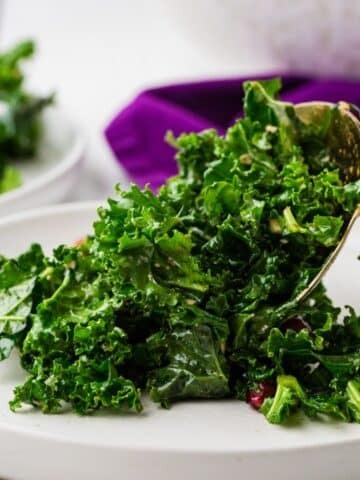 Kale and Pomegranate Salad
Kale and Pomegranate Salad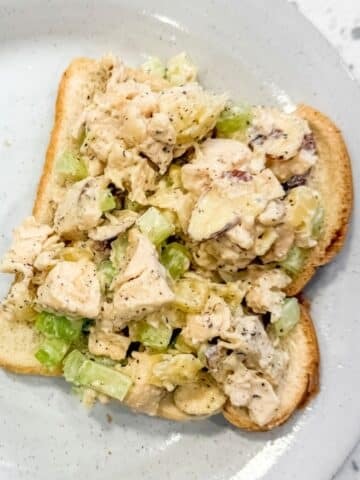 Hawaiian Chicken Salad
Hawaiian Chicken Salad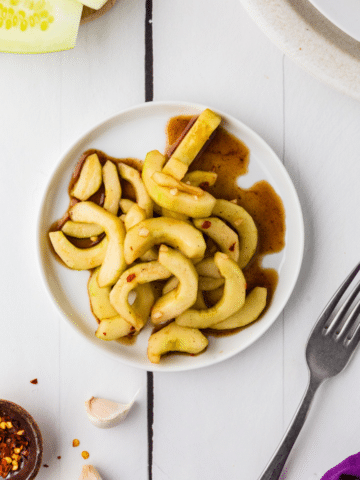 Spicy Cucumber Salad
Spicy Cucumber Salad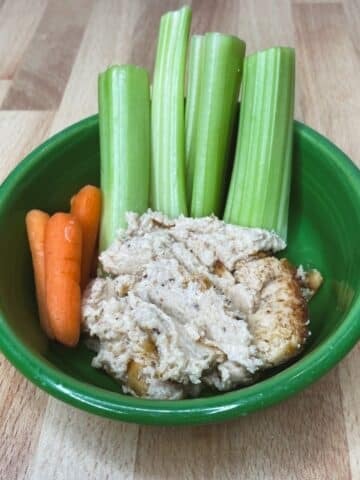 Buffalo Cauliflower DipPairing with Vegetarian Dishes
Buffalo Cauliflower DipPairing with Vegetarian DishesThese are my favorite dishes to serve with White Bean Dip Recipe with Seasoned Pita Chips:
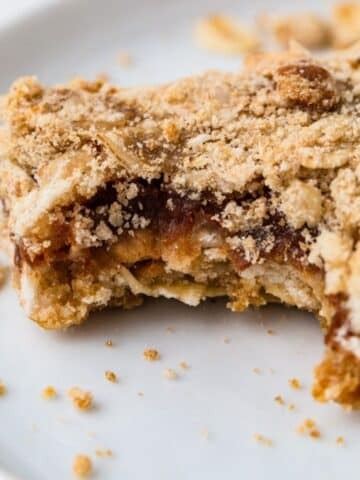 Healthy Oatmeal Date Bars
Healthy Oatmeal Date Bars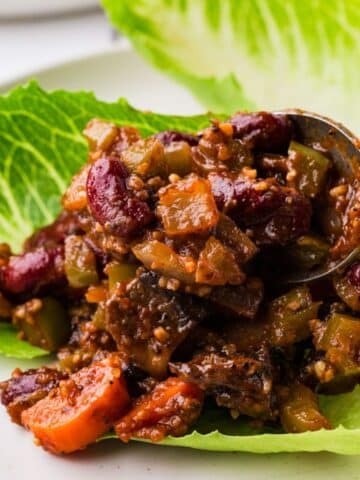 Vegetarian Sloppy Joes
Vegetarian Sloppy Joes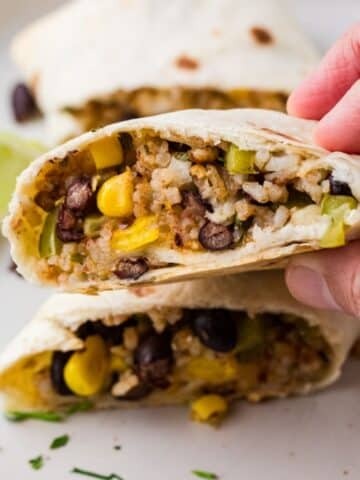 Black Bean and Rice Burrito
Black Bean and Rice Burrito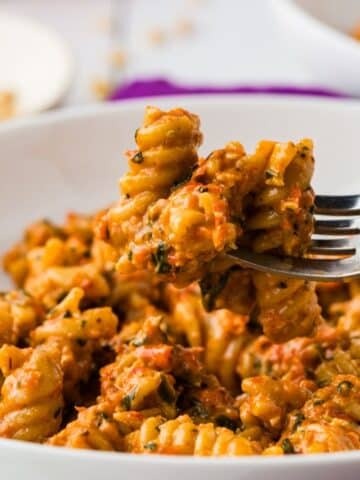 Roasted Red Pepper Pesto Pasta
Roasted Red Pepper Pesto PastaIf you tried this Recipe or any other recipe on my website, please please leave a star rating and let me know how it goes in the comments below. I love hearing from you!
Recipe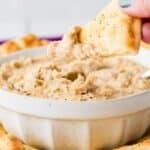 PrintWhite Bean Dip Recipe Vegan#wprm-recipe-user-rating-1 .wprm-rating-star.wprm-rating-star-full svg * { fill: #343434; }#wprm-recipe-user-rating-1 .wprm-rating-star.wprm-rating-star-33 svg * { fill: url(#wprm-recipe-user-rating-1-33); }#wprm-recipe-user-rating-1 .wprm-rating-star.wprm-rating-star-50 svg * { fill: url(#wprm-recipe-user-rating-1-50); }#wprm-recipe-user-rating-1 .wprm-rating-star.wprm-rating-star-66 svg * { fill: url(#wprm-recipe-user-rating-1-66); }linearGradient#wprm-recipe-user-rating-1-33 stop { stop-color: #343434; }linearGradient#wprm-recipe-user-rating-1-50 stop { stop-color: #343434; }linearGradient#wprm-recipe-user-rating-1-66 stop { stop-color: #343434; }#wprm-recipe-user-rating-1.wprm-user-rating-allowed.wprm-user-rating-not-voted:not(.wprm-user-rating-voting) svg * { fill-opacity: 0.3; }Prepare a delightful appetizer by baking golden, crispy pita wedges and pairing them with a smooth, flavorful white bean dip. This easy-to-make snack combines Mediterranean influences and can be enjoyed by anyone following a low-calorie, vegan, or low-salt diet. This dip is a great snack or appetizer for twelve.Course Appetizer, SnackCuisine American, MediterraneanDiet Low Calorie, Low Fat, Low Lactose, Low Salt, Vegan, VegetarianPrep Time 10 minutes minutesCook Time 10 minutes minutesServings 12Calories 110kcalAuthor Mathea Ford, RDN, LD, MBAIngredients6 small-pita PITA BREAD WHITE, ENRICHED, 4'' diameter3 tablespoon OLIVE OIL salad or cooking1 teaspoon PEPPER BLACK, GROUND2 cup WHITE BEAN Cannellin Beans, Drained and Rinsed1 tablespoon GARLIC RAW2 tablespoon LEMON JUICE UNSWEETENED, single strength1 teaspoon SAGE GROUND4 tablespoon OLIVE OIL salad or cooking1 tablespoon Texas TwistGet ingredients with
PrintWhite Bean Dip Recipe Vegan#wprm-recipe-user-rating-1 .wprm-rating-star.wprm-rating-star-full svg * { fill: #343434; }#wprm-recipe-user-rating-1 .wprm-rating-star.wprm-rating-star-33 svg * { fill: url(#wprm-recipe-user-rating-1-33); }#wprm-recipe-user-rating-1 .wprm-rating-star.wprm-rating-star-50 svg * { fill: url(#wprm-recipe-user-rating-1-50); }#wprm-recipe-user-rating-1 .wprm-rating-star.wprm-rating-star-66 svg * { fill: url(#wprm-recipe-user-rating-1-66); }linearGradient#wprm-recipe-user-rating-1-33 stop { stop-color: #343434; }linearGradient#wprm-recipe-user-rating-1-50 stop { stop-color: #343434; }linearGradient#wprm-recipe-user-rating-1-66 stop { stop-color: #343434; }#wprm-recipe-user-rating-1.wprm-user-rating-allowed.wprm-user-rating-not-voted:not(.wprm-user-rating-voting) svg * { fill-opacity: 0.3; }Prepare a delightful appetizer by baking golden, crispy pita wedges and pairing them with a smooth, flavorful white bean dip. This easy-to-make snack combines Mediterranean influences and can be enjoyed by anyone following a low-calorie, vegan, or low-salt diet. This dip is a great snack or appetizer for twelve.Course Appetizer, SnackCuisine American, MediterraneanDiet Low Calorie, Low Fat, Low Lactose, Low Salt, Vegan, VegetarianPrep Time 10 minutes minutesCook Time 10 minutes minutesServings 12Calories 110kcalAuthor Mathea Ford, RDN, LD, MBAIngredients6 small-pita PITA BREAD WHITE, ENRICHED, 4'' diameter3 tablespoon OLIVE OIL salad or cooking1 teaspoon PEPPER BLACK, GROUND2 cup WHITE BEAN Cannellin Beans, Drained and Rinsed1 tablespoon GARLIC RAW2 tablespoon LEMON JUICE UNSWEETENED, single strength1 teaspoon SAGE GROUND4 tablespoon OLIVE OIL salad or cooking1 tablespoon Texas TwistGet ingredients with  InstructionsPreheat oven to 375'F.Line a rimmed baking sheet with parchment paper. Cut each pita into 8 equal sized wedges. Lightly brush pita wedges with olive oil on both sides and place on lined baking sheet.Season pita with pepper before placing in oven. Bake for 5-6 minutes before turning each wedge. Return to oven and continue baking for another 5-6 minutes, or until pita wedges are golden brown. Remove from oven and set aside.Add white cannellini beans, minced garlic, lemon juice, sage, Texas twist spice, and olive oil to the bowl of a food processor or blender and blend until smooth.Pour bean mixture into a serving bowl and season with pepper to taste. Serve with seasoned pita chips or vegetables.NotesE X C H A N G E S : 1.14 Starch, 0.04 Vegetable, 0.01 Fruit, 1.55 Fats, 0.01 Other CarbsNutritionCalories: 110kcal | Carbohydrates: 7g | Protein: 2g | Fat: 8g | Saturated Fat: 1g | Polyunsaturated Fat: 1g | Monounsaturated Fat: 6g | Sodium: 5mg | Potassium: 144mg | Fiber: 2g | Sugar: 0.2g | Vitamin A: 1IU | Vitamin C: 1mg | Calcium: 25mg | Iron: 1mg | Phosphorus: 29mgCheck Out Our Meal Plans For People With Chronic Kidney Disease (CKD)
InstructionsPreheat oven to 375'F.Line a rimmed baking sheet with parchment paper. Cut each pita into 8 equal sized wedges. Lightly brush pita wedges with olive oil on both sides and place on lined baking sheet.Season pita with pepper before placing in oven. Bake for 5-6 minutes before turning each wedge. Return to oven and continue baking for another 5-6 minutes, or until pita wedges are golden brown. Remove from oven and set aside.Add white cannellini beans, minced garlic, lemon juice, sage, Texas twist spice, and olive oil to the bowl of a food processor or blender and blend until smooth.Pour bean mixture into a serving bowl and season with pepper to taste. Serve with seasoned pita chips or vegetables.NotesE X C H A N G E S : 1.14 Starch, 0.04 Vegetable, 0.01 Fruit, 1.55 Fats, 0.01 Other CarbsNutritionCalories: 110kcal | Carbohydrates: 7g | Protein: 2g | Fat: 8g | Saturated Fat: 1g | Polyunsaturated Fat: 1g | Monounsaturated Fat: 6g | Sodium: 5mg | Potassium: 144mg | Fiber: 2g | Sugar: 0.2g | Vitamin A: 1IU | Vitamin C: 1mg | Calcium: 25mg | Iron: 1mg | Phosphorus: 29mgCheck Out Our Meal Plans For People With Chronic Kidney Disease (CKD)The post Low Sodium White Bean Dip appeared first on Renal Diet HQ.



